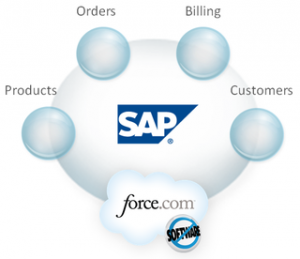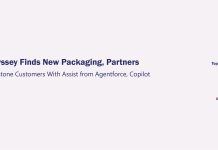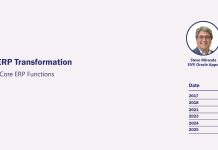In the annals of the software industry, it’s often a zero sum game when vendors start jockeying for new positions in an effort to gain shares and by necessity wipe out others including the incumbent and the bystanders along the way.
The events this week were indicative of another round of musical chairs on display portending to one of the biggest upheavals in the applications market.
Two of the major vendors Salesforce.com and SAP have traded places – one positioning itself as the next platform vendor after becoming an on-demand pioneer, the other seizing the opportunity to expand in the on-demand market by leveraging its enterprise-grade technology platform.
Salesforce.com Positions Itself As Preferred Platform
First Salesforce.com has done a superb job selling Customer Relationship Management applications via the on-demand delivery model to 87,000 customers and close to two million users. With the help of a growing army of 310,000 developers, Salesforce.com is positioning itself as the de-facto Cloud platform vendor by making a series of moves including the launch of Database.com at its Dreamforce event this week.
By selling a standalone cloud database, Salesforce.com can reduce the burden of its developers by allowing them to focus more on Web scripting and the user interface layer, rather than spending time on such tasks as database tuning. Thus Database.com becomes another major ammunition in Salesforce.com’s evolving platform strategy.
The idea is to use the Cloud infrastructure that it has been building for the past decade to deliver database services that its developers can readily connect to their products, which in turn will help make Salesforce.com’s platform strategy far-reaching. More than 1,000 applications have already become available on its AppExchange Marketplace, which serves as the distribution arm for products based on the fast-growing Force.com platform.
The platform now encompasses a slew of Web services such as Appforce for apps delivery, Siteforce for website creation, the newly acquired Heroku for social media apps based on Ruby, ISVforce for multitenancy enablement, and VMforce for rapid Java development through the partnership with virtualization leader VMWare.
Using the playbook from the automotive industry, Salesforce.com is offering a complete set of tools and widgets for others to build cars except the paint job and the emblem on the hood.
SAP Aims To Be On-Demand Over-Achiever
SAP, which has been the No. 1 vendor in such markets as Enterprise Resource & Planning, is upping the ante in the on-demand space with an upcoming version 2.6 of Business ByDesign as well as Line of Business apps for tasks such as Travel OnDemand, Sales OnDemand, and Career OnDemand that can be readily accessed over the Internet.
At its Influencer Summit SAP outlined its corporate vision. Its on-demand strategy took up the bulk of the two-day agenda with many of its on-demand products nearing ramp-up distribution in 2011.
After making a string of acquisitions including BusinessObjects for analytics and Sybase for information management, SAP is fashioning itself not just as a dependable platform and application vendor, but also an agile on-demand provider.
Combining its NetWeaver platform that offers portal and integration capabilities with its extensive portfolio of on-premise business applications, SAP has made significant inroads into large enterprises as well as small to midsized companies. SAP estimates that 75% of business transactions worldwide is being handled by its software demonstrating the integrity and scalability of the NetWeaver platform.
What SAP hopes is to enhance NetWeaver with lightweight extensions called River Platform for its on-demand environment. The River Platform is built using variation of C#, added PHP capabilities for easy scripting, but retaining the robustness of ABAP language.
The River Platform, aided by new technologies like in-memory database and StreamWork for social media collaboration, will make its on-demand offerings more compelling by delivering features like expense management, carbon impact management and sales force automation easily accessible over the Web and mobile devices.
Another key differentiator of its on-demand strategy is its seamless integration into on-premise applications from SAP, something that should sway its installed base of more than 100,000 customers. Aggressive pricing with per user per month subscription fees dropping as low as $13, or €10, for large enterprises is also in the cards. For SMBs, the cost of getting SAP Business ByDesign for CRM for 10 users up and running is $31,000, which is in line with on-demand offerings from its competitors.
The performance and look and feel of SAP Business ByDesign has also improved after incorporating technologies like Microsoft Silverlight for rich media interface. Additionally SAP is invested heavily in its Network Solutions to optimize connectivity and ensure reliability when its on-demand offerings become broadly available in 2011.
To put SAP’s shift from a platform paradigm to an on-demand play in a larger context, one has to look at how the vendor has been evolving its technology roadmap since it unveiled NetWeaver in 2003 and sustained the development with continuous innovation from Duet to Master Data Management, putting to rest the persistent complaints that it received from users about the complexity of connecting its applications to a dizzying array of middleware.
The growing successes of NetWeaver – handling tasks like real-time trading network and compressing ERP implementations to a fraction of the time needed previously – have been further bolstered by acquired technologies such as embedded analytics from BusinessObjects and mobile databases from Sybase. And their multiplying effects underscore the fact that SAP is on the verge of replicating its platform achievements to the on-demand level.
Risks and Opportunities
Salesforce.com’s venture into the platform play is fraught with challenges. First not every one of its ISV partners embraces its platform strategy. The cool reception is particularly acute among long-time partners such as Silverpop in the email marketing space because of its reluctance to abandon its existing on-demand platform, which is not built on Force.com, but has been widely deployed at more than 1,000 major customers. Silverpop does offer interfaces to Salesforce.com products like Chatter.
Another challenge is the core competency of Salesforce.com, which is still better known for its CRM apps than delivering a broad set of solutions from claims processing to financial compliance. Repositioning Salesforce.com as a platform provider could mean undoing the strong brand equity that it has spent so much time building.
Then there is the question of the long-term commitment of Salesforce.com’s platform play. At first glance, it appears to be a relatively convenient way for Salesforce.com to extend the database infrastructure that it has been using to support its customers as the basis of its Database.com cloud service. By contrast SAP paid $5.8 billion for Sybase to get into the database market.
For SAP, the challenge has more to do with its decision to contain the scope of its on-demand strategy by lowering public expectations. Having experienced lackluster results with its early releases of Business ByDesign, SAP is playing safe. Because of its decision to control the River Platform as well as how ISV partners and customers will be able to run the platform on private and public clouds, SAP may end up exercising too much caution and stalling its momentum.
That could curtail massive ISV involvement when the rapid buildup of a critical mass is more important than ever. Heroku, which was acquired by Salesforce.com this week for $212 million, has attracted a critical mass of developers building more than 100,000 apps on its hosted Ruby platform only three years after it was founded.
The last time that such remarkable role reversals took place was in the 1990s when Netscape aimed to dethrone the Windows franchise held by Microsoft with its Navigator browser. It didn’t take long for Netscape to extend the simple browser to include collaboration and eCommerce applications as the preferred platform for the Web. We all knew what happened to Netscape when Microsoft reasserted its platform power, propelling its dominance in browser by consistently enhancing its own Internet Explorer and making impressive gains in other markets from collaboration to portal with Outlook and SharePoint.
Netscape blazed the trail that now serves as the catalyst for vendors like Salesforce.com and even SAP to deliver a new generation of applications and Web services. The question is whether Salesforce.com’s transformation into a platform vendor will fall into the same trap that ensnared Netscape or SAP’s high-stakes gamble in on-demand could come at the expense of its lucrative on-premise ERP franchise.
What’s more likely to happen is that if Salesforce.com and SAP were to succeed with their latest moves, other vendors might have to see erosion in their shares.
That means current platform heavyweights such as IBM, Microsoft and Oracle could see considerable customer defections, while on-demand leaders like Concur, NetSuite and SuccessFactors might have to settle for less.
After I posted the blog, SAP contacted me to clarify its platform strategy and plans. Here’s what Jeff Stiles, senior vice president of On-Demand Marketing at SAP, has to say:
Our vision is to deliver an application Platform-as-a-Service (PaaS) built on a simplified technology stack with a rich set of transactional, collaborative and analytical services and components that developers of all types can choose from to build on demand apps as required. Developers can use the SAP’s on demand platform to build new, CORE transactional applications as well as lightweight EDGE applications to complement and extend existing on premise and on demand applications:
- CORE: SAP Business ByDesign and SAP Business ByDesign Studio form the CORE platform for building applications that are business process oriented, transactional, data centric. It leverages the services and end-to-end business processes provided by SAP Business ByDesign, such as Line of Business On Demand, supply-chain / logistics On Demand, Sales On Demand, etc.
- EDGE: The technology of project “River” is evolving as the foundation for building EDGE or lightweight utility applications with discrete functionality that are typically deployed in a “networked” fashion, such as “an approval app for SAP Business Suite”, “a collaboration app for budget review”, or “an online credit check app”, etc.
The platform is built for enabling interoperability through openness and at the same time providing the service framework required to ensure security & integrity required by applications operating in a networked, distributed environment.






